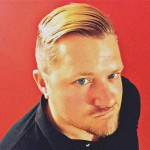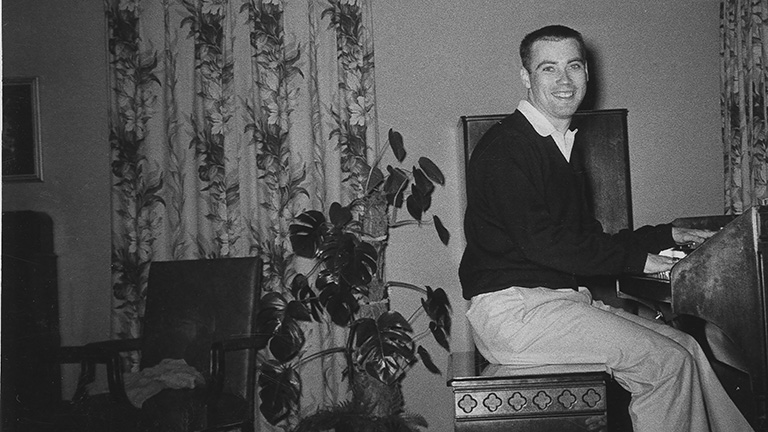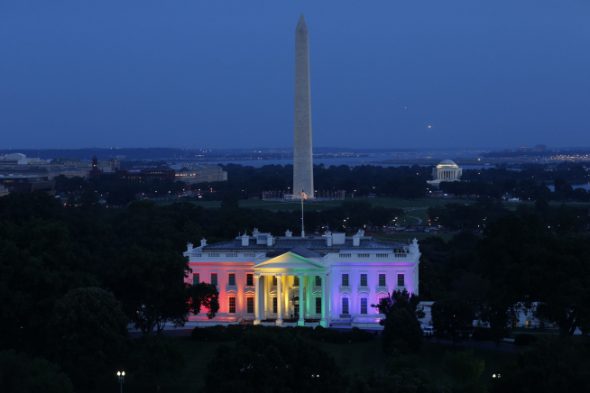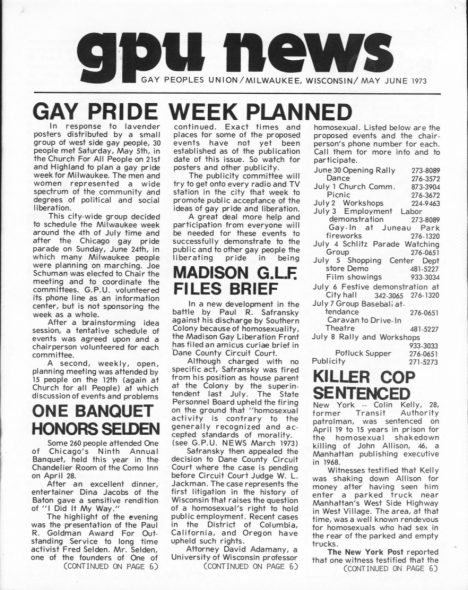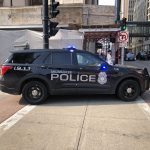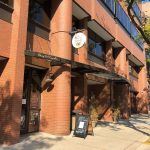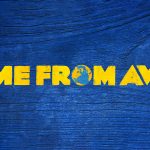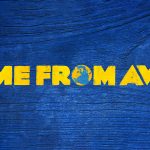The Enduring Legacy of Eldon Murray
So much of the LGBTQ revolution in Milwaukee was the result of his work.
When Eldon Murray (1930-2007) was a teenager, he sought to find some reflection of himself in the world. It was very easy to believe, at the time, that no other gay people existed – and that’s what society wanted people of his generation to believe.
There was no internet. There was no gay media or mail order. There were no gay-straight alliances in schools. There were no gay people in movies. There was only crushing homophobia everywhere he turned. Eldon scrapbooked news clippings for decades, highlighting or underlining code words the midcentury media used to describe homosexuals. These headlines usually included the words “sexual deviate,” “pervert,” “invert,” “molestor,” “dishonorable,” and almost always, “criminal.”
Eldon knew what these words really meant. He’d often cross them out and add his own word, “GAY.”
Sadly, these arrest records were the only mentions most gay people ever saw before the 1970s. This approach was as deliberate as it was destabilizing. By criminalizing and demonizing gay people, society sought to keep them scared, silent and invisible. The concept of being out, much less being proud, was impossible for a suppressed sub-community known only when they were being shamed.
“We were considered sinful. We were considered criminal. We were considered sick,” said Barbara Gittings, founding president of the Daughters of Bilitis, “so that sickness label infected everything we said and did. It made it very difficult for us to have any credibility for ourselves.”
“The going theory at the time was, you were sick, and so you should go to the doctor and get turned around,” said Barbara. “Anybody with any income at all went to the therapist to get straightened out. Not too many people thought for themselves, or they would have thought, ‘this is a crock of shit.’”
Is it any wonder that our elders experienced immeasurable emotional, psychological and physical health issues, trapped within this pressure cooker of self-loathing? For decades, LGBTQ people were defined only by their sexual identity, but then subjected to scandal, scorn and stigma for being sexual. Some chose dangerous and destructive “conversion therapy” – others were forced or sentenced – and many of those spent the rest of their lives in a joyless, catatonic state. Alcoholism, drug addiction, self-harm and suicide impacted the community at disproportionate rates – and still do.
For most of the 20th century, LGBTQ people had to work – very hard – to see hints, nods and allusions of their own existence in the media. But what was more damaging: representation of nothing – or misrepresentation of everything?
My generation had four gay stereotypes to choose from: the sassy flamboyant, the serial killer, the AIDS patient and (by the 1990s) the asexual gay best friend. They were played for laughs, shock value, or after-school special level “relevancy,” and usually as foils for a hetero-heavy story written by straight writers. They weren’t relatable or realistic, and usually depressing and often offensive. I can’t imagine these overdone characters being inspiring role models for anyone, more likely the cause of serious confusion. “If I don’t look or act like the gay characters on TV, does that mean I’m not gay?” was an actual question people asked themselves.
Nowadays, we are more likely to complain about overrepresentation, through the opportunistic pride-jacking of rainbow capitalism, than not being represented in the world. Each year, GLAAD reports a record-breaking number of diverse LGBTQ characters on network TV, with last year’s percentage of 8.8 percent higher than ever before in broadcast history. Familiarity breeds acceptance – and perhaps, overexposure – as we now face the challenge of being crowded out of the few remaining gay bars and neighborhoods by trend-setting straights seeking to be supportive allies.
When national marriage equality arrived in June 2015, everything from Niagara Falls to the White House was illuminated in pride colors. (Although, strangely, not a single Milwaukee building participated.) Four years later, five million visitors celebrated the 50th anniversary of the Stonewall uprising at WorldPride 2019 in New York City. Twenty-one buildings lit up in pride colors for the weekend. With over 150,000 parade participants, including some of the world’s most trusted online and offline brands, WorldPride might just have been the largest expression of LGBTQ visibility in American history.
How far we’ve come, and how often I wish our long-lost elders could be here to see it. It would have meant so much to them to finally see people like themselves in the world, to know they weren’t sick, evil or damaged people, and to feel the pride that they were long denied.
Much of that improvement in Milwaukee (and the battle isn’t over locally or nationally) came because of the work of Eldon Murray. Murray grew up in a time without acceptance or support. He realized he had to become the change he wanted to see in the world. When only a handful of people were leading the movement nationwide, Eldon mobilized Milwaukee’s gay community to action. He founded many cornerstones that are still thriving today, as well as the city’s first gay press, pride events, radio program, free clinic and crisis line.
Eldon inspired people to rise up, be seen, and be heard, not just in Milwaukee, but around the country. Throughout the gay liberation movement, he was still haunted by the absence and exclusion of LGBTQ role models in his youth, and sought to reclaim and restore them for future generations.
To this day, most of Milwaukee’s LGBTQ-supporting organizations can trace their genealogy back to Eldon Murray. The Milwaukee Pride Parade originated with the Gay Liberation Front’s 1971 parade. Milwaukee Pride is descended from Pride Week 1973 and the GPU Ball of 1974. The Milwaukee LGBT Community Center traces back to GPU’s Farwell Community Center of 1975. BESTD Clinic was born as the GPU VD Clinic of the 1970s. When the AIDS epidemic hit Milwaukee hard, Eldon wrote the grant for what became the Milwaukee AIDS Project (now AIDS Resource Center of Wisconsin.) In his senior years, he founded SAGE Milwaukee to support the needs of LGBTQ elders.
In 1998, the One National Gay and Lesbian Archives recognized Eldon as one of the nation’s top 30 gay rights pioneers. He’d already received numerous local awards, including Wisconsin Senior Statesman, Milwaukee County Senior Citizen Hall of Fame and Cream City Pace Setter.
When oppressed people are activated to be their best selves, they can achieve the impossible.
Imagine a Milwaukee where an entire generation of Eldon Murrays overcame the fear and loathing of the 1950s with the strength and resilience to change the world. Where would we be today?
Imagine a Milwaukee where the next generation of Eldon Murrays are empowered and emboldened their entire lives — by positive, supportive heroes helping them become their own best selves.
Where could we be tomorrow?
If you think stories like this are important, become a member of Urban Milwaukee and help support real independent journalism. Plus you get some cool added benefits, all detailed here.
Out Look
-
The Flag Stands for LGBTQ People, Too
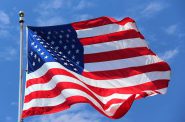 Jul 4th, 2019 by Michail Takach
Jul 4th, 2019 by Michail Takach
-
The Battle for Juneau Park
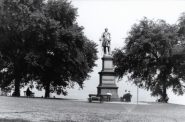 Apr 14th, 2017 by Michail Takach
Apr 14th, 2017 by Michail Takach
-
The Evolution of Drag
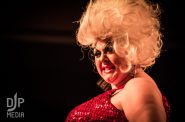 Mar 30th, 2017 by Michail Takach
Mar 30th, 2017 by Michail Takach

